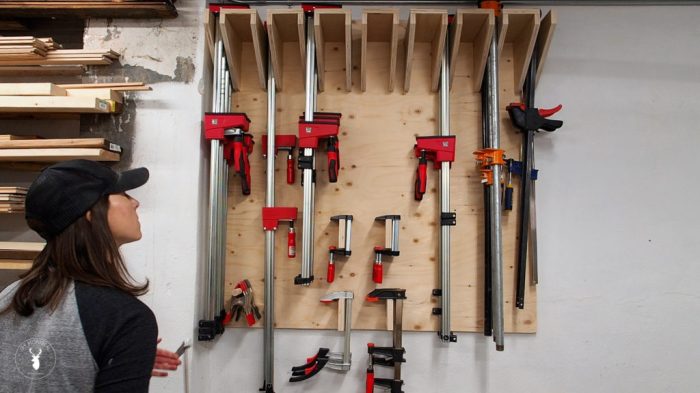DIY Clamp Rack: A well-organized workshop is a dream for any DIY enthusiast, and a dedicated clamp rack is the key to achieving that dream. Imagine a space where your clamps are readily accessible, neatly stored, and easily identifiable. This guide will take you through the steps of building your own clamp rack, ensuring you have a system that keeps your clamps organized and within reach for every project.
Building a DIY clamp rack not only enhances your workshop’s functionality but also provides a sense of accomplishment. You’ll gain valuable skills in woodworking and learn to design a storage solution tailored to your specific needs. This project is accessible to DIYers of all levels, from beginners to experienced craftspeople.
Materials and Tools for Construction: Diy Clamp Rack

Building a DIY clamp rack is a simple project that requires readily available materials and basic tools. The specific materials and tools will vary depending on the size and design of your clamp rack. This section Artikels essential materials and tools, along with alternative options based on your budget and availability.
Materials
The materials needed for a DIY clamp rack will depend on the design and size of the rack. However, some common materials include:
- Wood: This is the most common material for clamp racks. You can use different types of wood, such as pine, plywood, or hardwood, depending on your preference and budget. Pine is the most affordable option, while hardwood is more durable and aesthetically pleasing.
- Metal: Metal is another option for building a clamp rack. Metal is more durable than wood and can withstand heavier loads. You can use metal pipes, angle iron, or sheet metal to build your rack.
- Fasteners: You will need fasteners to assemble your clamp rack. Common fasteners include screws, bolts, nuts, and washers. Choose fasteners that are appropriate for the materials you are using.
- Glue: Wood glue can be used to strengthen the joints of your clamp rack, especially if you are using wood. Use a high-quality wood glue for best results.
- Paint or stain: This is optional, but you can paint or stain your clamp rack to match your workspace or to protect it from wear and tear. Choose a paint or stain that is suitable for the material you are using.
Tools, Diy clamp rack
You will need basic tools to construct your DIY clamp rack. The specific tools will vary depending on the design and materials you are using. Here are some common tools:
- Saw: A saw is essential for cutting wood or metal to size. You can use a handsaw, circular saw, or miter saw, depending on your preference and the size of your project. A jigsaw is helpful for cutting curves or intricate shapes.
- Drill: A drill is needed to create pilot holes for screws and to drill holes for fasteners. A cordless drill is more convenient than a corded drill, especially if you are working on a large project.
- Screwdriver: You will need a screwdriver to drive screws and bolts. A power screwdriver can speed up the process.
- Measuring tape: A measuring tape is essential for accurate measurements and cutting. Make sure to use a measuring tape that is in good condition and has a clear scale.
- Level: A level is important for ensuring that your clamp rack is straight and level. Use a level to check the horizontal and vertical alignment of your rack.
- Clamps: You will need clamps to hold the pieces of your clamp rack together while you are assembling it. Use clamps that are appropriate for the size and weight of your project.
Alternative Materials and Tools
If you are working with a limited budget or have limited access to tools, you can use alternative materials and tools. For example, you can use scrap wood instead of purchasing new lumber. You can also use a hand drill instead of a power drill. If you don’t have a saw, you can ask a local hardware store to cut the wood for you.
You can also use alternative methods to assemble your clamp rack. For example, you can use dowels or biscuits instead of screws to join the pieces. These methods require specialized tools, but they can be a good alternative if you don’t have a drill or screws. You can also use a combination of different methods, such as using dowels for some joints and screws for others.
A DIY clamp rack is a rewarding project that brings immense benefits to your workshop. By creating a dedicated space for your clamps, you’ll save time, reduce frustration, and enjoy a more organized and efficient workspace. Whether you’re a seasoned craftsman or just starting your DIY journey, a well-built clamp rack is an essential investment in your woodworking success.
A DIY clamp rack can be a great addition to any workshop, keeping your tools organized and easily accessible. If you’re looking to shed some pounds while you build your rack, you might want to consider looking into saxenda weight loss options. Once your rack is built, you can start tackling those projects with renewed energy and confidence.
